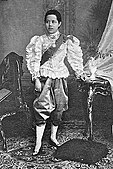Sompot Chong Kben

Etymology
Sompot Chong Kben (សំពត់ចងក្បិន)
History
This article's factual accuracy is disputed. (June 2018) |
This article contains wording that promotes the subject in a subjective manner without imparting real information. (June 2018) |
The history of sompot chong kben dates back to ancient
In Ramayana mythology, Hanuman is a symbol of bravery, cleverness, and power, so the people, when wearing the sompot chong kben, always drop a tail at the back like Hanuman's monkey tail. This practice lead a lot of people to believe that all Indians were guards of Hanuman. The influence of sompot chong kben, known as
In the middle of the 13th and 14th centuries, Thai people (from Sukhothai Kingdom, known as Thailand today) and Lao people (from Lan Xang, known as Lao today) had adopted the wearing of sompot chong kben from Khmer.[12] They considered it superior for enjoying the special occasions, and useful for royalty or monarchy in their local royal palace, the Thai people and Lao people had used sompot chong kben in a similar way.[13][10]
Images
-
Photograph of Prince Chulalongkorn (Rama V) and his two younger brother wearing chong kraben in 1851
-
Photograph of a 19th century Siamese boatman, photographed by John Thomson
-
Photograph of Queen Saovabha Phongsri, principal consort to King Chulalongkorn
-
6th century Khmer depiction ofTakeo, Cambodia. Now exhibits in National Museum of Cambodia.
-
Khmer woman wearing Sompot Chong Kben
-
A Khmer traditional dancer in Sompot Chong Kben
-
Khmer royal ladies wearing Sompot Chong Kben andSbaiin the mid-1800s.
-
Mannequins wearing Sompot Chong Kben at the Royal Palace of Cambodia
See also
- Khmer Traditional Dress
- Culture of Cambodia
- Culture of Thailand
- Dhoti
- Sompot
- Sarong
References
- ^ "SEAlang Dictionary". www.sealang.net. Retrieved 2023-10-11.
- ^ "Everything You Need to Know About Traditional Thai Dresses". Amazing Thailand.
Men and women alike wear Chong Kben, a lower-body silk wrap-around garment adopted from Cambodia.
- . Retrieved 18 February 2020.
- ^ "SEAlang Dictionary". www.sealang.net. Retrieved 2023-10-11.
- ^ "SEAlang Dictionary". www.sealang.net. Retrieved 2023-10-11.
- ^ "SEAlang Dictionary". www.sealang.net. Retrieved 2023-10-11.
- ^ "SEAlang Dictionary". www.sealang.net. Retrieved 2023-10-11.
- ^ *Sereysothera Archived November 3, 2010, at the Wayback Machine
- ^ "តើខ្មែរប្រើប្រាស់សម្លៀកបំពាក់ពីពេលណា?". Archived from the original on 2009-08-18. Retrieved 2009-09-04.
- ^ a b Nadeem, Zuha (2019-10-01). "Traditional Thai Clothing-16 Beautiful Outfits From Thailand". Outfit Trends - Ideas How to Wear & What to Wear. Retrieved 2020-03-09.
- ^ "Sompot Chong Kben". Archived from the original on 2012-02-26. Retrieved 2009-09-04.
- ^ Highlights, Asia. "Thai Traditional Dress". Asia Highlights. Retrieved 2020-03-14.
- ^ "ខ្មែរស្លៀកសំពត់ចងក្បិនពីពេលណាមក ?".








